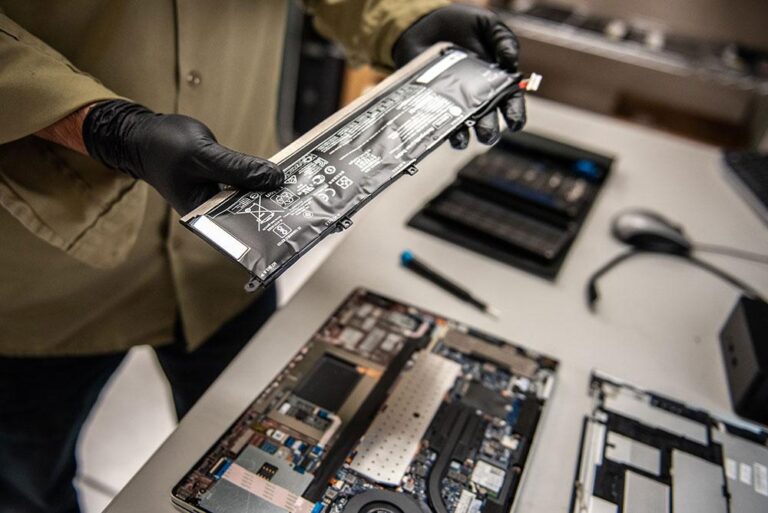Table of Contents
- Understanding the Risks and Limitations of Repairing Damaged Batteries
- Effective Methods for Diagnosing Battery Damage and Assessing Repairability
- Safe Practices for Handling and Preparing Batteries for Recycling
- Choosing Certified Recycling Facilities to Ensure Environmental Compliance and Safety
- The Way Forward
Understanding the Risks and Limitations of Repairing Damaged Batteries
Repairing damaged batteries often comes with a set of significant risks that cannot be overlooked. Batteries, especially lithium-ion types, contain volatile chemicals and operate under high pressure, making the repair process potentially hazardous. Mishandling can lead to thermal runaway, causing fires or explosions. Moreover, the complexity of battery construction means that even minor internal damage might not be visible externally, increasing the chance of improper repairs that compromise safety and performance. It’s crucial to understand that DIY fixes or untrained interventions may inadvertently weaken the battery’s structural integrity, leading to early failure or dangerous malfunctions.
In terms of limitations, repairing damaged batteries tends to be both technically challenging and economically impractical. Most batteries are designed as sealed units with integrated safety mechanisms, which makes disassembling and refurbishing them difficult without specialized equipment. Additionally, even if a faulty battery can be partially restored, its capacity and lifespan will often be significantly reduced compared to a new unit. For these reasons, alternatives such as proper recycling or replacement are generally recommended. When considering what to do with a damaged battery, keep in mind:
- Environmental impact: Improper disposal or attempted repairs may lead to chemical leaks harmful to the environment.
- Cost-effectiveness: Repair costs can exceed the price of a new battery, along with hidden risks.
- Safety standards: Certified recycling centers follow strict protocols to safely handle and recover valuable materials.
Effective Methods for Diagnosing Battery Damage and Assessing Repairability
Assessing the condition of a battery requires a blend of visual inspection and advanced diagnostic techniques. Start by looking for external signs of damage such as swelling, corrosion, leaks, or burn marks, which often indicate internal failures. Next, employ tools like a multimeter to measure voltage levels and a battery analyzer to test capacity and internal resistance. These tests reveal the battery’s health by identifying if cells are underperforming or short-circuited. Portable diagnostic devices and software applications can also offer insights into the battery’s charge cycles, temperature history, and real-time performance data, all critical for an accurate evaluation.
When it comes to determining repairability, consider the extent and type of damage. Minor problems like sulfation or slight capacity loss can sometimes be reversed with specialized reconditioning methods such as controlled charging and chemical treatments. However, severe physical damage or compromised internal components often renders repair unsafe or ineffective. Key factors that influence the decision include:
- Age and usage history: Older batteries or those heavily used may not justify repair costs.
- Safety risks: Damaged batteries with leakage or swelling pose explosion hazards.
- Cost-effectiveness: Often replacement outweighs repair expenses for severely damaged cells.
- Environmental impact: Assess if recycling is a better solution to prevent hazardous waste.
Safe Practices for Handling and Preparing Batteries for Recycling
Handling batteries, especially those that are damaged, requires a strict adherence to safety protocols to prevent accidents such as leaks, fires, or explosions. Before recycling, ensure that the battery terminals are covered with non-conductive tape to avoid short-circuiting during transport. Always keep batteries in a cool, dry place, away from flammable materials and direct sunlight. When packaging, use sturdy, non-metallic containers that provide separation between individual batteries to minimize physical damage and potential chemical exposure. Never attempt to open, puncture, or disassemble damaged batteries as this can release hazardous substances.
Key safety tips include:
- Wearing protective gloves and eyewear when handling compromised batteries.
- Inspecting batteries for signs of bulging, corrosion, or leakage and isolating those in poor condition.
- Transporting batteries in an upright position to reduce the risk of electrolyte spills.
- Following local regulations and guidelines for battery disposal and recycling centers.
Choosing Certified Recycling Facilities to Ensure Environmental Compliance and Safety
When dealing with damaged batteries, selecting a certified recycling facility is crucial to uphold both environmental standards and safety protocols. These facilities adhere to strict guidelines set by regulatory bodies, ensuring that hazardous materials such as lithium, lead, and cadmium are handled with care. Their certification verifies that they employ specialized equipment, skilled personnel, and effective waste management practices to prevent contamination and potential health risks.
Key benefits of using certified recycling facilities include:
- Compliance with local and international environmental laws, reducing legal liabilities.
- Proper containment and neutralization of toxic substances found in damaged batteries.
- Advanced sorting techniques that maximize material recovery and minimize landfill waste.
- Safe transportation and disposal methods designed to protect both workers and nearby communities.
The Way Forward
In conclusion, while some minor battery issues can be addressed with proper care and knowledge, attempting to repair damaged batteries is often risky and not recommended for most users. Safety should always be the top priority, as mishandling damaged batteries can lead to hazardous situations. Fortunately, safe and responsible recycling programs exist to ensure that these power sources are disposed of in an environmentally friendly manner. By choosing to recycle rather than repair when in doubt, we not only protect ourselves but also contribute to a more sustainable future. Remember, when it comes to damaged batteries, prevention, caution, and proper disposal are always the best policies.Check Our Other Blogs
- StunGun – Your Trusted Source for Stun Guns, Laws, and Self-Defense Tips
- PepperSprayLaws – Your Trusted Resource for Pepper Spray Information
- StunGunLaws – Your Trusted Guide to Stun Gun Legality and Safety





